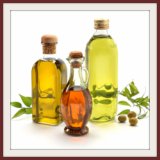Olive Oil Glossary & Definitions
- Acidity - Acidity is the level of oleic acid or monounsaturated fat (good fat) found in olive oil. Olives should be pressed within 48 hours of picking. The longer they are left unpressed the more the acid builds within the olive itself, which leads to higher acidity levels. The lower the acidity, the better the olive oil is and the tastier it is to the taste buds.
- Cold-pressed - Refers to a process that is chemical-free using only pressure in order to produce the high quality of olive oil that is naturally low in acidity.
- Monounsaturated Fat - Considered to be the healthiest type of fat, it is mainly found in olive oil, nuts and seeds, and rapeseed oil.
Monounsaturated fat is believed to lower cholesterol and have been known to help reduce or
prevent heart disease.
Olive oil is a prime component of the Mediterranean Diet and as such the high consumption of olive oil in Mediterranean countries is considered to be one of the primary reasons why the folks living in these regions have lower levels of heart disease.
- Oleic Acid - Refers to the monounsaturated fatty acid found in olive oil.
- Refined Olive Oil - Refer to olive oil that has been processed and therefore, has higher acid content than the
extra-virgin olive oil. It is of lesser grade and therefore, not recommended for daily cooking.However, this grade of olive oil would be fine for home remedies.
Some of the best and finest extra virgin olive oils in the world have the low range of acidity from 0.3%-0. 7%. Be sure to check the label for the acidity level when purchasing your olive oil. Remember, the level of acidity is one of the key factors along with aroma, flavor and color in finding the best and finest olive oils. Click here to select olive oils with different levels of acidity.










